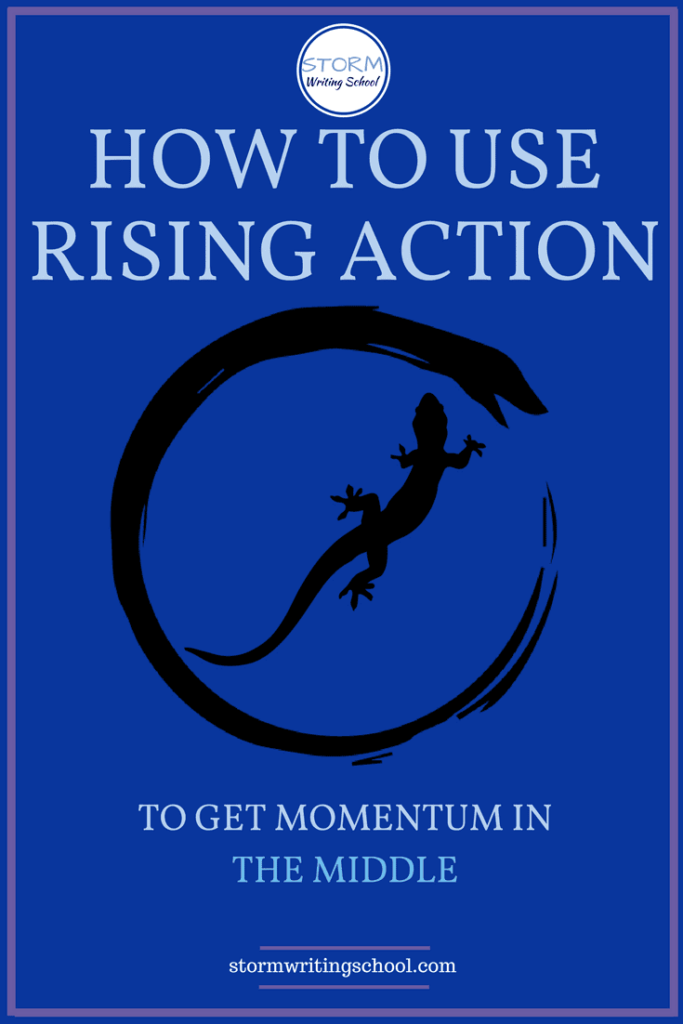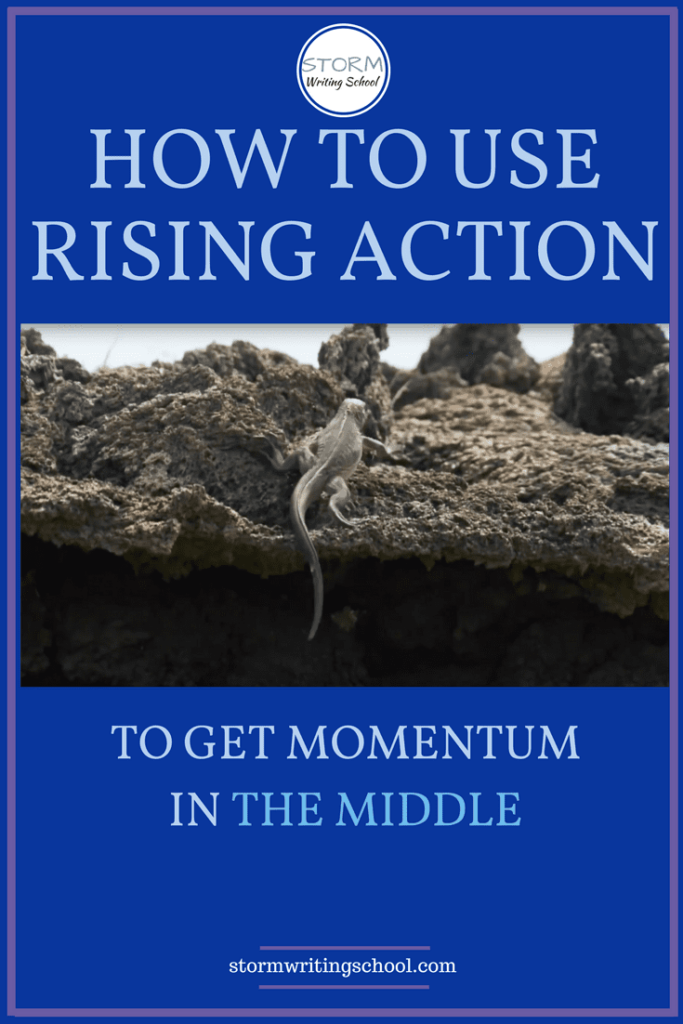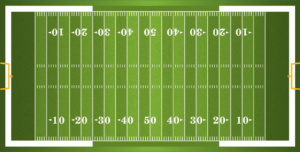“Escalating complications” is my preferred term for what’s commonly known as “rising action.” What is rising action? And how can you use it to maintain reader engagement in the middles of your scenes and stories?

When we think about stories—and as we’re inventing them as writers—we tend to pay more attention to beginnings and endings: where did things start; where did they end? It’s the middles that sometimes get short shrift. To a certain extent, it’s natural that beginnings and endings get all the attention. They’re the points that get imprinted in our memories. We list things we did by their starts (went to college, moved to California, started dating Ashley) and by their endings (graduated, left California, broke up with Ashley). But the beating hearts of stories often come from the middle, in large part from the section commonly referred to as “rising action.”
In the video posted below, I delve into an analysis of a nature documentary excerpt from the BBC, which gives us a well-crafted story that gets its draw largely from how the middle was structured. Take a look.
Below the video is a rough transcript and a downloadable aid for helping you come up with ideas about escalating complications.
Transcript
When you’re telling stories to friends or family, it’s fine if your story fizzles out after the initial hook:
You: I was at the grocery store just now and this guy in the parking lot had an armadillo on a leash!
Your friend: What? That’s weird.
You: I know, right?
Your friend: Yeah. That reminds me of this one time when I was in Florida . . .
That’s the way real life stories often go. They’re not really stories. They’re just observations. And then we’re off on another snippet of life.
But if we’re going to write a story, it needs to go somewhere from there. In fact, if we think about graphing a story with the story’s sequence on the x axis and the audience engagement on the y axis, the story needs to go up from the begining.
That’s why this section of the story is sometimes called “rising action.” It provides increasing conflict, which makes the audience more and more hooked.
Allow me to demonstrate this using a brilliant little video put together by the BBC for their Planet Earth II series. This 2-minute clip gives us a perfectly structured story with a superb middle. It shows us a veritable instructional manual in how to create compelling rising action by incremental steps of increasing danger and stakes. Or in this case, snakes. Ha!
Now, you may want to watch the video in its entirety before I break it down for you, so pause and click the link below if you haven’t seen it yet, but come back to see why it’s so brilliant with its story craft.
Desire and Conflict
You’ll note that right off the bat, they establish the two things that every story needs: a desire and a conflict, aka a goal and antagonism, aka objective and obstacle. Use whatever language you want, but the protagonist (which, yes, in this case is a lizard) needs to want something and there must be something that impedes or thwarts or otherwise gets in the way of the protagonist attaining that goal. That is the essence of what drives any story. And here, it’s established right away.
We recognize the basic contest of snake vs. iguana, and with the help of the voiceover narration, we get allied with the iguana hatchling immediately: “If the hatchling keeps its nerve, it may just avoid detection.”
Parts
Now, a key part to understanding how rising action works is to break the scene or story down into parts. In this case, we have a few different beats in this scene. If we were talking about a feature-length film, we might talk about acts. What we call these parts isn’t all that important at this point. But it is important to recognize distinct parts, and they’re actually determined by desire and conflict.
The first part of this story is about avoiding detection, just as the voiceover tells us. That’s what determines part one here: the goal is to avoid detection.
Does the hatchling avoid detection? No. He fails at that. Now, he’s got a new objective. Part 2, then, is to outrun the nightmare of snakes coming after him.
Does he outrun them? Well, no. He gets caught.
But he gets away. And now, he’s on to Part 3, a new objective, which is to climb up the rocks, to go where the snakes cannot go easily.
Now, note how things ramp up
In Part 1, it’s iguana vs. snake. A snake. Yes, there are others there, but the camera focuses in on this one snake, venturing out toward the frozen iguana.
In Part 2, it’s the whole group of snakes. We have escalated here. Twenty snakes are more dangerous than 1. But luckily for the iguana, these snakes are incompetent, which makes them a little less threatening than they otherwise might be.
In Part 3: things are even worse. Why? Three reasons—and this is all about how the scene is being constructed by the cinematic storytellers here: 1) Snake teeth. We get multiple shots of snakes lunging at the hatchling with open mouths. 2) Desperation. The snakes seem more desperate, as evidenced by their willingness to throw themselves into cravasses to get the hatchling. 3) The terrain. This hatchling has to jump across the crevasses. So I would argue that even though the number of snakes seems to have been reduced in this third part, the overall threat is greater.
And then keep in mind that as the protagonist gets nearer the goal, the more tragic it is to fail, right? I mean, if you’re in a race and you fall within the first three meters, it’s a lot less dramatic than if you fall within the last three meters, so to have a finish line or safety in sight also serves to make the third part of the story more intense.
And that’s what rising action is all about. Creating parts that incrementally up the threat of failure, either by bringing in greater conflict or by making failure more tragic.
Now, when you see diagrams of rising action, you sometimes see it depicted as steps, and the logic of that is illustrated by this story, which has three clear steps.
I prefer to call it escalating complications. Shawn Coyne of Story Grid refers to it as progressive complications, but notes, too, that they must escalate. And that’s really the key concept here.
Apply to your writing
Think about creating cycles of success or failure. But with each new cycle, you want to incrementally step up the conflict and/or stakes.
I created a quick worksheet to get your started on brainstorming how you can escalate complications within your work-in-progress. Subscribe and I’ll send it to you right away:
[thrive_leads id=’3228′]
If you found the above helpful, you’ll love my courses on tension. I’ve got a big one on Story Momentum Mastery, which you should only sign up for if you’re serious about learning how to create more engaging stories, and I’ve got a smaller one on how to use mystery, suspense, and dramatic irony to create tension in your stories. The most recent course is a short seminar on creating sexual/romantic tension. Subscribe if you haven’t yet.

SaveSave
SaveSave
SaveSave
SaveSave
SaveSaveSaveSave
SaveSave
SaveSave
SaveSave
SaveSave
SaveSave
SaveSave
SaveSave
SaveSave
SaveSave








8 Responses
I did not know you broke up with Ashley, bro. When was this? Did you… you know, do the breaking up thing or was it, ah… mutual? Anyway, you sound great and it looks like you landed on your feet. But if you’re hurting, writing helps. I have so much unnecessary violence and slaughter in these stacks of legal pads I wonder if I’m destined to always the writer be, never the protagonist or sidekick. Some days I’d settle for hapless villain.
That snake story is great! Point recieved! Nice job.
Isn’t it? I love the narrative they pieced together. Thanks, Christine!